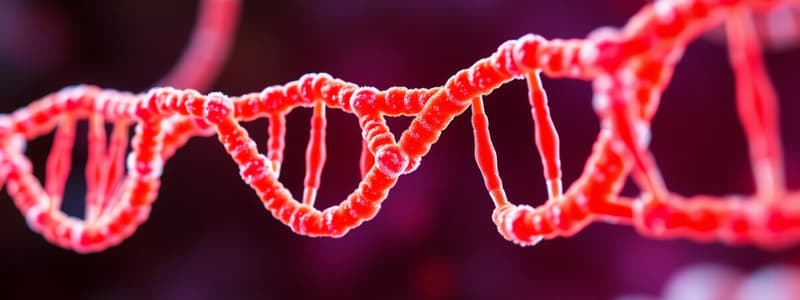Podcast
Questions and Answers
What is the function of insulin in the human body?
What is the function of insulin in the human body?
- To produce red blood cells
- To transport oxygen to the tissues
- To break down carbohydrates
- To regulate blood sugar levels (correct)
Which of the following is NOT a type of bonding?
Which of the following is NOT a type of bonding?
- Hydrogen bonding
- Covalent bonding
- Ionic bonding
- Gravitational bonding (correct)
What is the primary function of the respiratory system?
What is the primary function of the respiratory system?
- To break down food
- To transport oxygen and carbon dioxide (correct)
- To produce hormones
- To filter waste products
In a eukaryotic cell, where is ATP produced?
In a eukaryotic cell, where is ATP produced?
Which of the following processes describes the movement of water across a semipermeable membrane from a region of high concentration to a region of low concentration?
Which of the following processes describes the movement of water across a semipermeable membrane from a region of high concentration to a region of low concentration?
What is the difference between a prokaryotic cell and a eukaryotic cell?
What is the difference between a prokaryotic cell and a eukaryotic cell?
Which of the following is an example of a heterogeneous mixture?
Which of the following is an example of a heterogeneous mixture?
Which of the following describes the process of evolution?
Which of the following describes the process of evolution?
Flashcards
Structure of DNA
Structure of DNA
DNA is a double helix made of nucleotides, each containing a sugar, phosphate group, and nitrogenous base.
Mitosis
Mitosis
Mitosis is the process of cell division that results in two identical daughter cells.
Eukaryotic vs. Prokaryotic Cells
Eukaryotic vs. Prokaryotic Cells
Eukaryotic cells have a nucleus and organelles; prokaryotic cells lack a nucleus.
Role of ATP
Role of ATP
Signup and view all the flashcards
Osmosis
Osmosis
Signup and view all the flashcards
Function of Insulin
Function of Insulin
Signup and view all the flashcards
Photosynthesis Process
Photosynthesis Process
Signup and view all the flashcards
Types of Muscle
Types of Muscle
Signup and view all the flashcards
Study Notes
DNA and Chromosomes
- Describe the structure and components of DNA
- Describe the structure of sex chromosomes
- Define mitosis, meiosis, mutation, non-disjunction
Atoms and Bonding
- Describe the parts of an atom and electron movement
- Describe different types of bonding
- Describe an element
Chemistry Concepts
- Define science
- Define biology
- Define hypothesis
- Different types of chemistry
- Define acidity, basicity
- Define eukaryotic and prokaryotic cells
- Define ATP function
- Filtration, diffusion, osmosis, active transport
- Define reactant, solution, precipitate, product, compound, chemical reaction
- Homogeneous and heterogeneous mixtures
- Define evolution
- Hydrogen bonding to form water, carbon dioxide, carbon monoxide
- Define mass, weight, density, solid, liquid, gas, matter, mixture
- Describe bacteria and viruses
- Animal cell anatomy
Human Body Systems
- Organization of biological structures (smallest to largest)
- Skeletal, muscular, respiratory, cardiovascular, immune, integumentary, endocrine, nervous, reproductive, digestive systems function
- Cardiovascular system anatomy and blood flow
- Blood components (parts of blood, types of blood cells)
- Types of muscle
- Insulin function
- Fertilization, ovulation, menstruation
- Nose, mouth, hair, nails anatomy and function
Plant Structure and Function
- Plant categories
- Water uptake process by plants
- Air exchange in a leaf
- Plant cell structure and function
- Cellulose function
- Plant pollination
- Photosynthesis and respiration processes
- Ecosystem description
Studying That Suits You
Use AI to generate personalized quizzes and flashcards to suit your learning preferences.




